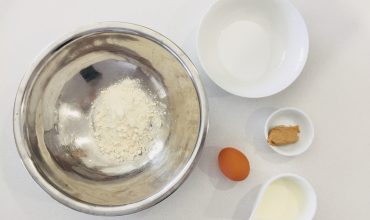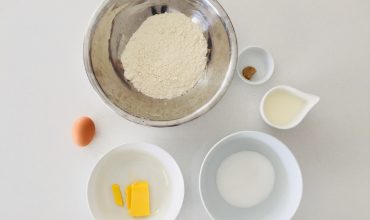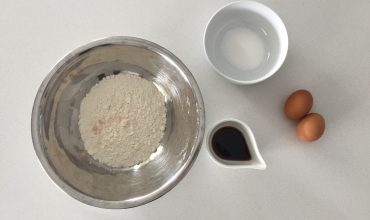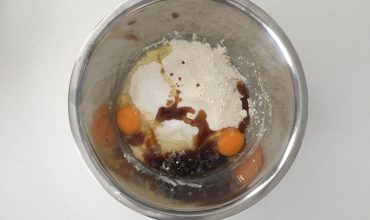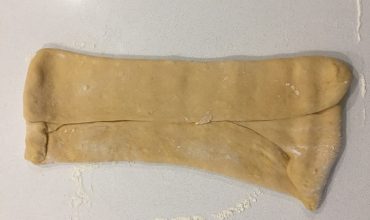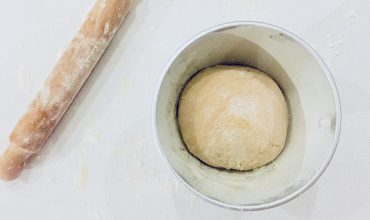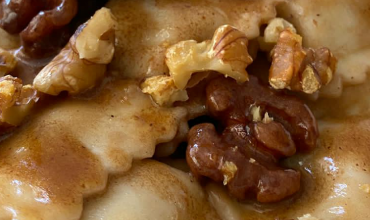Pandoro for the Festive Season
Styling: Anita Parise & Renee Lenzarini
Blog: Anita Parise
Photography & Video: Anita Parise & Renee Lenzarini
Recipe & Inspiration: Christmas traditions and specialties
“Ahhhh, it’s nearly THAT time of year again … CHRISTMAS! And I am not at all organised! The kids are hounding me for every toy that has been strategically placed on prime-time kid’s telly. They also shove countless catalogues that get squished into my mailbox under my nose, right about the time I am trying to enjoy my morning coffee. I have been hearing daily since the start of October:
“Muuuuuuuummmmmm, can I have this?”
My response? “Yes! Absolutely darling. Be good and Santa might bring it for you.”
I have also in as many sentences threatened them with a sack of potatoes …. Neither option seem to be working for me right now ;).
As stressful as this time of year can be for most people, one thing I know for sure is, kids and adults alike love to eat Panettone and Pandoro. “What’s the difference?”, I hear you ask.
Similar to the French brioche, pandoro is a traditional Italian sweet bread, most popular around Christmas and New Year. The name ‘pandoro’ – quite literally translated – means ‘golden bread’. Traditionally shaped like an 8 pointed tall star, it is often served dusted with vanilla flavoured icing sugar made to resemble the snowy peaks of the Italian Alps near Verona.
‘Panettone’, on the other hand, is slightly more traditional, typically containing candied orange, citron, and lemon zest, as well as raisins – which are added dry and not soaked.
Everyone in Italy eats these festive specialties during the holiday season. Nothing quite beats a fluffy panettone or pandoro, sliced and toasted for breakfast or used to make French toast and/or served with whipped cream, dark chocolate, fresh fruit or mascarpone and a chilled glass of prosecco or dessert wine. Theses delicious sweet cakes can even be hollowed out and filled with ice-cream like a Florentine zuccotto. In honesty, it all comes down to personal preference. I know that in my household the candied orange and ‘bits’ – as my kids refer to them as – are not appreciated, so pandoro it is!
I had never tried to make a pandoro before and had always wanted to try. I had searched for a while online to see if I could find a recipe that didn’t take 3 days to make (slight exaggeration there.) So I attempted to make a pandoro ‘cake.’ It was terrible. In fact, it went straight into the bin! I have to admit that I did cry a little as I really wanted this to work out the way the images portrayed it to look.
So, on the hunt I went again to find another recipe. With not really knowing what to look for I went with the recipe that had decent reviews and that only was supposed to take 3 active hours not 13 hours like some others suggested. Lesson learnt … there is no cheating in making pandoro!
Renee and I decided to give the 3 hour recipe a go and the jury is still out on this one. It is not the same type of Pandoro that I am used to eating. That is, beautifully light and fluffy. That gentle pull apart – sweet golden goodness (can you tell I absolutely love the stuff?) The elements that I am looking for in a quality pandoro were certainly lacking. The flavour was still quite yeasty to me and not as sweet as I was used to. This version of pandoro instead is ideal once toasted and eaten with lashings of jam or marmalade.
I did learn that the time it took to make vs the outcome for me wasn’t worth it. I’d much rather go and buy a beautifully presented, perfectly shaped and ever so delicious one from my local supplier (I thought I’d never say such a thing …. but now I have!) This must be the reason why Italians choose to buy their pandoro instead of baking them at home. Luckily Golden Ravioli have a wonderful selection in store this Christmas to cater to every taste. Whether you’re a traditionalist or unorthodox when it comes to eating panettone, there’s no topping the quality of Dolci di Romeo and their gorgeous festive packaging.
Please check out the recipe that was tested and tell us what you really think. We would love to hear if you have a fail proof pandoro or panettone recipe!
Enjoy the lead up to Christmas GR Clubbers. Eat your most favourite festive specialities, drink and be merry (as much as possible).”
Buon Appetito,
Anita, Renee & the GR Team
Ingredients
*Notes from Anita & Renee:
- If you cannot obtain fresh yeast, packet yeast is fine. I would use one sachet and divide it up in the separate steps.
- We suggest also adding in season lemon or orange zest to this.
- 50g of plain flour
- 60ml of milk, warmed
- 15g of fresh baker's yeast
- 40g of castor sugar
- 1 x egg yolk
- 200g of plain flour
- 120g of castor sugar
- 1 x egg
- 3g of fresh baker's yeast
- 60ml of milk
- 30g of unsalted butter, softened
- 200g of plain flour
- 2 x eggs
- 30g of castor sugar
- 1 pinch of salt
- 60ml of vanilla extract
- 140g of unsalted butter, softened
Method
Before starting this Pandoro Cake recipe, make sure you have organised all the necessary ingredients.
- Pour the warm milk over the fresh yeast. Combine with a whisk until dissolved completely. Make sure the milk is not too hot, as it may kill the yeast. Add the castor sugar, one egg yolk and combine the ingredients.
- Add 50 grams of flour and combine until it forms a soft dough. Cover with a cloth and leave to prove in a warm room, until the dough has doubled in volume. Let rise for at least one hour.
- When the dough has doubled in volume, remove the cloth.
- Dissolve 3 grams of fresh yeast with 3 tablespoons of milk (at room temperature). Add 120 grams of castor sugar, one whole egg and combine the ingredients.
- Pour the yeast preparation over the dough. Next, add 200 grams of flour and combine well with a spatula.
- Add 30 grams of soft butter and combine until the dough is smooth.
- Scrape the dough that is stuck on the sides of the bowl and cover with a tea towel. Leave to prove in a warm room, until the dough has doubled in volume. Let rise for at least one hour.
- When the dough has doubled in volume, add 200 grams of flour, 2 whole eggs, 30 grams of castor sugar, a pinch of salt, 60 mls vanilla extract and combine all ingredients with a spatula.
- Scrape the dough that is stuck on the sides of the bowl and cover with a tea towel. Leave to prove in a warm room, until the dough has doubled in volume.
- Once it has doubled in volume, knock the dough back with the palm of your hand, scrape the dough from the sides of the bowl and cover with cling film. Store in the fridge overnight.
- The following day, remove the dough from the fridge. Despite being in the fridge, the dough should have risen. This is totally normal! Knock the dough back and transfer onto a floured bench.
- Using a rolling pin, roll the dough out to a square (30 x 30cm). Then, using a palette knife, spread the soft butter into a thin layer.
- Fold the four corners towards the centre making sure the edges join.
- Roll out the dough into a rectangular strip making sure the butter is not coming out from the sides.
- Give the dough a quarter-turn (anticlockwise). Fold the dough into thirds (the same method as puff pastry) and refrigerate for 30 minutes.
- Roll out the dough into a rectangle. Give the dough a quarter-turn (anticlockwise). Fold the dough into thirds (the same method as puff pastry) and refrigerate for 30 minutes. o Roll out the pastry again, lengthwise.
- Give the dough a quarter-turn (anticlockwise). Fold the dough into thirds (the same method as puff pastry) and refrigerate for 30 minutes.
- Finally, roll the dough out to form a square (30 x 30cm). Fold the four corners towards the centre. Repeat the operation, folding the four corners towards the centre again.
- Flip the dough square and gently shape it into a ball.
- Grease a pandoro cake tin with oil or cooking spray. We used a dolly cake mold, alternatively you can use a normal cake tin but line it with baking paper at least 25 cm above the cake tin rim.
- Place the dough ball at the bottom of the mold and push it down. Leave to prove in a warm room. Cover with a cloth until the dough has risen up to the top of the pan. Depending on the temperature, this operation should take between 1 and 2 hours.
- Remove the cloth once it has almost reached the top of the mold, and leave to prove with no cover. This prevents the cloth from sticking to the dough and ruining the surface of the pandoro.
- Place a bowl filled with hot water at the back of the oven.
- Preheat the oven to 170°C (not fan forced – preferably on a bake setting if you have one) and bake for 15 minutes. Then reduce the heat to 160°C and bake for a further 30 minutes.
- To check whether the pandoro is cooked, insert the blade of a knife in the centre. When you take it out, nothing should stick to the blade.
- When cooked, remove from the oven. Gently release from the tin while it is still hot and leave to cool.
- o When cooled down completely, generously dust the icing sugar over the pandoro.

